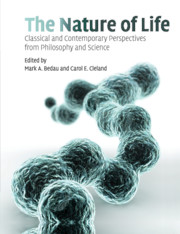Book contents
- Frontmatter
- Contents
- Preface
- Acknowledgments
- Sources
- About the authors
- Introduction
- SECTION I CLASSICAL DISCUSSIONS OF LIFE
- SECTION II THE ORIGIN AND EXTENT OF NATURAL LIFE
- 8 The origin of life: a review of facts and speculation
- 9 Small molecule interactions were central to the origin of life
- 10 Are the different hypotheses on the emergence of life as different as they seem?
- 11 The universal nature of biochemistry
- 12 Is there a common chemical model for life in the universe?
- 13 Searching for life in the universe: lessons from Earth
- 14 The possibility of alternative microbial life on Earth
- 15 Introduction to the limits of organic life in planetary systems
- SECTION III ARTIFICIAL LIFE AND SYNTHETIC BIOLOGY
- SECTION IV DEFINING AND EXPLAINING LIFE
- Supplementary bibliography on life
- Index
- References
13 - Searching for life in the universe: lessons from Earth
Published online by Cambridge University Press: 10 November 2010
- Frontmatter
- Contents
- Preface
- Acknowledgments
- Sources
- About the authors
- Introduction
- SECTION I CLASSICAL DISCUSSIONS OF LIFE
- SECTION II THE ORIGIN AND EXTENT OF NATURAL LIFE
- 8 The origin of life: a review of facts and speculation
- 9 Small molecule interactions were central to the origin of life
- 10 Are the different hypotheses on the emergence of life as different as they seem?
- 11 The universal nature of biochemistry
- 12 Is there a common chemical model for life in the universe?
- 13 Searching for life in the universe: lessons from Earth
- 14 The possibility of alternative microbial life on Earth
- 15 Introduction to the limits of organic life in planetary systems
- SECTION III ARTIFICIAL LIFE AND SYNTHETIC BIOLOGY
- SECTION IV DEFINING AND EXPLAINING LIFE
- Supplementary bibliography on life
- Index
- References
Summary
Within the next decade, NASA, in conjunction with colleagues from several nations, will embark on one of the most exciting missions yet undertaken in the exploration of space: the return of samples from Mars. The mission, which has been moved back several years, will almost certainly have an architecture similar to that originally planned for the Mars 03/05 mission (shown in Fig. 13.1). That is, it will have two separate launches, each of which will conduct experiments on the surface of Mars, retrieve and store samples, and put these collected samples into Mars orbit in two separate sample canisters. Subsequently, a Mars orbiter (sample return vehicle) will be employed to retrieve the orbiting sample canisters, and return them to Earth for analysis. Probably by 2011 we should have on Earth the samples from the surface of Mars on the order of 1–2 kg for scientific study. These samples will add an immense amount to our knowledge of the solar system, and of Earth itself, and will also be carefully scrutinized for the presence of indicators of present or past life on the red planet. Given the absence of any obvious features on Mars that suggest life, and the negative results (with regard to life) obtained in the Viking mission of the 1970s, a skeptical observer might well ask, “Why send such a mission?”
- Type
- Chapter
- Information
- The Nature of LifeClassical and Contemporary Perspectives from Philosophy and Science, pp. 186 - 197Publisher: Cambridge University PressPrint publication year: 2010



